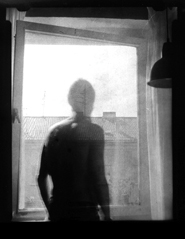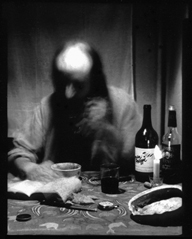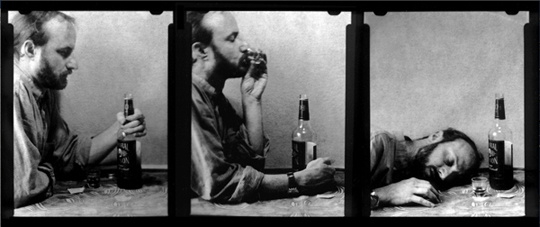It was a dark and stormy night in Berlin...
In the winter of 1999, I rented a tiny apartment in the very heart of the old East Berlin. The building I moved in to was in pretty bad shape, but rent was less than $200 per month and the neighborhood promised to be beautiful. If I could survive until spring.
I began the renovation of the flat, painting, repairing, and moving in my possessions. The year 2000 came and the winter weather got worse. I wasn't sure if I'd made a mistake in taking this apartment.
I felt lonely and isolated.

One day I came across a very old, large-format camera in a nearby junk shop. I bought it and brought it home with me. It turned out to be a 100-year-old portrait camera. It had a very nice lens, but no shutter.
It seems that photographers of that period used to pose their subject in a stiff chair, take off the lens cap for a few seconds, and then replace the lens cap. Film sensitivity was low enough that this was good enough for the exposure.
I decided to try out the camera. I couldn't find the right film for the film holder, so I began experimenting with photo paper instead. An especially thin, old, French photo paper turned out to work well and I began using it as negatives. Since photo paper is much less sensitive than film, my exposures had to be quite long, running into minutes and not seconds.

After shooting still lifes around my flat for a few days, I found that the correct exposure inside my flat was three minutes at f-11.
Since it was a portrait camera, I wanted to shoot portraits. And since I had no willing subjects, I decided to document my own life. This meant positioning the camera, taking off the lens cap, placing myself quickly before the lens, trying not to move during a full three minutes, then quickly replacing the lens cap.

For a few weeks I took these odd documentary portraits of myself in the flat. I processed the paper negatives in a tiny darkroom I had built and make contacts of the images.
One night, I attempted to enlarge one of the paper negatives, and to my surprise, the results were wonderful. Since the negatives were not made of film, the enlarged images had no grain. Instead, they showed the texture of the fiber of the paper all through the image, which was beautiful.

This texture, combined with the extremely long exposures, added a special mood to the images that seemed to reflect quite well my mood and situation in Berlin--the loneliness, the darkness, the isolation in my new flat.
More than 10 years have passed since I took these images. The paper negatives and contacts lay forgotten in a box on a shelf in my Spain apartment until earlier this year when I came across them again by chance.
I showed them to a Spanish gallerist who told me she'd love to do an exhibition with them. My next step will be to enlarge them enough to appreciate the texture and details of the paper negatives. The final images will be larger than life-size.

|


